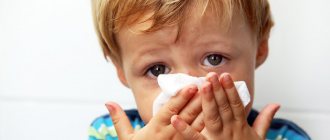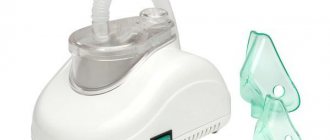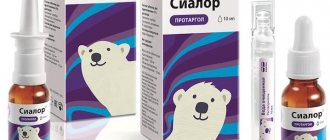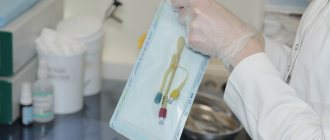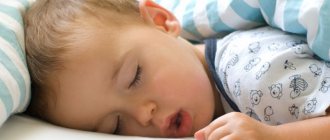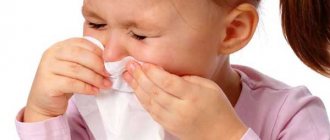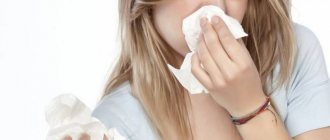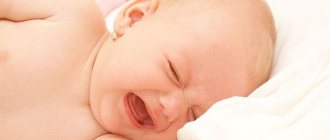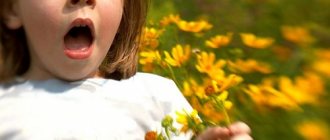Caution for Parents
If a child is 1 year old with a runny nose, it is better to read the recommendations before treating him. Most adults are accustomed to independently preventing and treating a runny nose, but snot in a one-year-old child can affect the general health of his fragile body. Improper treatment increases the risk of complications and spread of the inflammatory process to the pharynx or lower respiratory tract.
How dangerous is a runny nose for a 1 year old child?
If your baby's runny nose is not treated, the following unpleasant symptoms may occur:
- a decrease in the body’s protective functions due to the active development of microbes on the mucous membrane;
- difficult blood circulation and oxygen deficiency;
- sleep and appetite disturbances;
- irritability and tearfulness;
- the influence of harmful particles in the nose after the accumulation of mucus on the ciliary epithelium;
- development of complications against the background of a prolonged runny nose (bronchitis, asthma, sinusitis, otitis media, sinusitis);
- respiratory dysfunction.
How to identify a runny nose in a one-year-old child?
The inflammatory infectious process has three main stages. If it is recognized in time, the treatment of any runny nose in a one-year-old child will be reduced.
Reflex stage
Vasoconstriction occurs in the nasal mucosa. Discomfort manifests itself in the form of dryness and burning. The child does not show any complaints due to his age. Parents should be wary of constant sneezing and rubbing their nose with their hands. The initial stage can last several hours depending on the strength of the immune system. Already during this period it is necessary to take preventive measures.
Catarrhal stage
The vessels of the mucous membrane swell and expand, the inner surface turns red. In a child, the skin in front of the openings in the nose becomes inflamed and swollen. Clear, flowing mucus is released from the nasal cavity. The expansion of the capillaries leads to lacrimation and congestion. The catarrhal stage is observed from 2 to 5 days.
Last stage
The mucus thickens as much as possible and becomes difficult to separate. The addition of a bacterial infection changes the composition of the discharge. They acquire a yellow or greenish tint. Usually, with timely treatment of a runny nose in a 1-year-old child at this stage, complications do not arise. After a few days, the snot disappears completely, and the child can breathe freely.
In case of any deterioration in the child’s condition and suspicion of complications, consultation with a pediatrician and even hospitalization is recommended. If the temperature rises or the nose begins to bleed, self-medication is prohibited.
- In some cases, a runny nose without additional symptoms indicates teething. The inflammatory process in the gums affects the nasal cavity. Parents can use traditional treatment methods to relieve symptoms and restore breathing.
- It is prohibited to treat snot with pus in a one-year-old child through heating or steam inhalation. The process may indicate developing sinusitis, and temperature effects aggravate its course.
- If there is heavy discharge, the baby should not be in a hot room. Too dry and warm air negatively affects the inside of the nose. The mucous membrane dries out and the capillaries become brittle. This increases the risk of nasal bleeding.
- Potent vasoconstrictor drugs are dangerous for the baby. Their frequent use causes the opposite effect and addiction. Subsequently, after instillation, a violation of the olfactory function occurs.
- When using folk remedies, you should not use aggressive products (onions and garlic). Their active components and tannins can burn delicate mucous membranes.
- It is strictly forbidden to wash the baby’s nose with a strong stream from a syringe or other devices. The powerful pressure can damage the thin membranes connected to the eardrums.
How to safely and quickly cure a runny nose in a one-year-old child?
Many approved drugs are used to treat snot in a 1-year-old child. They are developed taking into account the characteristics of the child's body. There are also effective folk remedies that help cure a runny nose. But any independent use of medications or home recipes requires prior consultation with a pediatrician.
Harmless pharmaceutical products
If there is a strong flow of mucus from the nose, only children's drops can be used for the age of 1 year. The structure of the baby’s nasal passages at this age does not yet allow the use of sprays.
Popular drugs for the common cold for children 1 year old
- Aqua Maris. The drug consists of specially treated sea water. It contains natural mineral salts. Aqua Maris is used for various types of runny nose - acute, chronic, prolonged and allergic. Thanks to the use of sea water, the nasal mucosa is maximally moisturized, cleansed and prepared for further treatment. The drug has no age limit, it is safe and rarely causes an individual reaction.
- Aqualor Baby. The drops are made from water from the Adriatic Sea. They contain natural purified ingredients, and preservatives and dyes are excluded. Sterile water contains the necessary set of microelements. Aqualor cleanses the nasal mucosa, eliminates inflammation, and increases local immunity. The drug is used in the treatment of the runny nose and its complications - sinusitis and adenoiditis.
- Otrivin Baby. Made from a sterile solution with salts. The drug is used to cleanse and improve the condition of the nasal mucosa. After use, the reaction of local immunity improves. There are no aggressive impurities in Otrivin; its composition is the most natural for the body. With its help, when you have a runny nose, you perform daily hygiene of the nasal cavity.
- Nazol Baby. Designed to constrict blood vessels during severe runny nose. Phenylephrine quickly relieves internal edema, which stabilizes the child’s breathing. Nazol is successfully used for colds, flu and acute respiratory infections. The use of drops is allowed from birth, but no more than three days after the first nasal instillation. The vasoconstrictor drug requires a strict dosage.
- Vibrocil. Phenylephrine and dimethindene have a rapid vasoconstrictor effect. For better hydration and softening, it contains lavender oil. Vibrocil is intended to relieve swelling during severe nasal flow and facilitate breathing with any type of runny nose.
Traditional methods safe for one-year-old children
How to treat a common runny nose in a 1 year old child if it started suddenly and there are no proven medications at hand? To do this, many parents turn to proven traditional medicine.
Salt rinsing
If you have a severe runny nose, it is important to clear the airways of excess mucus by rinsing with salt. Add 3 grams of ordinary table salt to 100 ml of boiled warm water and mix well. To avoid damaging the delicate mucous membrane, the solution is administered carefully. A small pear-shaped enema is then used to suction out the nasal secretions. After this procedure, the child will breathe much easier.
Aloe drops
Aloe juice has an antibacterial and anti-inflammatory effect. But undiluted, it is as aggressive as onions. Fleshy leaves are suitable for treatment. They are doused with boiling water and the juice is squeezed out. Dilute it only with boiled water in a ratio of 1:20. It is recommended to drip the nose at least 5 times a day, 1 drop. In case of any reactions in the child, stop using the product.
Steam inhalation
Inhalation can be considered a fairly well-known folk method of treating colds, and their use for primary manifestations, such as a runny nose, leads to the fastest recovery. The steam, during inhalation, travels all the way through the respiratory system, warming the nasopharynx and cleaning the channels. Among the most effective recipes for inhalation, it is worth mentioning:
- hot honey solution;
- soda solution - about 3 tsp per liter of water;
- essential oils (can be used cold);
- potato peelings or jacket potatoes;
- buds of coniferous trees;
- herbal infusions - sage, oak bark, pine needles, linden and others.
Carrying out the inhalation procedure is not something complicated and the technique is known to almost everyone:
- Heat-resistant dishes, usually a kettle or a small saucepan, are filled with hot water.
- You need to add the main inhalation agent to the water, then wait for 5-8 minutes. In this case, the steam will be at the optimal temperature and will not burn sensitive mucous tissues.
- The patient is covered together with the inhalation “device” with a blanket.
- Breathing should occur alternately between nose and mouth. This will allow you to get the maximum effect in treating colds.
It may also be interesting: What you need to know about the runny nose and its treatment
In total, inhalations take only 10-15 minutes. After a specific treatment method, the child is thoroughly wiped dry and put to bed.
However, despite the effectiveness of such treatment, inhalations are contraindicated at elevated temperatures and acute febrile conditions.
Prevention of runny nose in babies at 1 year of age
- The room where the child plays and sleeps should be wet cleaned daily. Timely removal of dirt and dust particles promotes better functioning of the nose and prevents the entry of bacteria.
- Ventilation must be done twice a day. The optimal temperature for a child to sleep does not exceed 23 degrees Celsius. You can leave the window open in the room. The baby is put to bed in warm pajamas if it is a cold season.
- To strengthen the immune system, walk daily. Clothes should not restrict movement or be too hot. If the weather is too windy or rainy, you can go out with your child to the balcony or other protected area.
- Preventive aromatherapy can be performed twice a week. Essential oils are used for this. Just boil a pan of water, add 2 drops of eucalyptus, spruce or juniper oil. The air in the room will be humidified and saturated with particles of medicinal essential oils.
- At night, the nose near the passages is lubricated with oxolinic ointment. It is an excellent antiviral and antimicrobial agent.
Your pediatrician will advise you on how to properly treat a runny nose in a one-year-old child. If the snot does not go away for a long time at home, this may indicate the development of complications. In this case, continuing folk and drug therapy on your own is not recommended.
Treatment of runny nose in children with folk remedies at home
Children, due to the relative weakness of their immunity, often suffer from a runny nose. Rhinitis can be called one of the most common childhood ailments. Sometimes the disease has obvious causes, but sometimes the nose “blocks up” in a child who is outwardly completely healthy, and apart from impaired nasal breathing, there are no other complaints. Be that as it may, parents want to help the baby as soon as possible. It is not always possible to see a doctor, because clinics are closed on weekends and holidays. It is not customary to call an ambulance with complaints of a runny nose.
Prescribing medications to a child on your own is unsafe and risky, especially if we are talking about a small toddler. Parents can come to the aid of folk remedies that help get rid of a runny nose quite quickly.
Why does a runny nose appear?
A runny nose (rhinitis) is difficult to consider as an independent disease; it is usually a manifestation of a variety of disorders in the body. The nose stops breathing partially or completely due to inflammation of the mucous membranes of this organ. Most often, this is a consequence of resistance to pathogens and viruses.
As is known, viruses enter the body mainly through the respiratory system. The nose is the first line of defense; most often, invading viruses manage to pass further - into the nasopharynx, into the larynx. Inflammation of the mucous membrane in this case is an attempt by the body not to let the harmful agent pass further.
The episode of Dr. Komarovsky’s program about the causes and methods of treating children’s runny nose can be seen in the following video.
But several people inhale the same influenza virus through airborne droplets. But not everyone gets sick. Whether a runny nose starts or not depends not only on the state of the baby’s immunity. The development of rhinitis is greatly facilitated by various factors, such as dusty or polluted air, hypothermia.
There is another type of runny nose - non-infectious. This includes nasal congestion due to allergies (allergic rhinitis) and vasomotor rhinitis (associated with disturbances in the processes in the autonomic nervous system). They arise somewhat differently, as a result of narrowing of the lumen of blood vessels during a reaction to an antigen or vascular nervous pathology.
Acute rhinitis - occurs as a reaction to a virus (less often - to bacteria). With it, the swelling of the mucous membranes is quite strong, and it affects both halves of the nose. With it, the child may experience increased lacrimation, redness of the wings of the nose and the release of liquid mucus; people say “running nose”.
If such a runny nose is treated incorrectly or not treated at all, after 3-4 weeks the process will become chronic. With it, the nose will remain stuffy for a long time, the child’s sense of smell will noticeably decrease, the discharge from liquid will turn into thick, sometimes purulent, the mucous membrane will sometimes dry out, and crusts will form in the nasal passages.
Nasal breathing disorders in children occur due to various diseases:
- ARVI and influenza.
- Scarlet fever.
- Measles.
- Allergy.
- Vegetovascular dystonia.
- Proliferation of the palatine tonsil (adenoids).
- Other diseases.
A runny nose in a child can be mild, or it can be accompanied by fever, loss of appetite, headaches and severe general weakness. It is impossible to predict exactly what symptoms will accompany rhinitis; everything is purely individual.
How to quickly cure a runny nose in children
In order to treat a child for rhinitis, complex therapy should be carried out. The use of medicinal drops must be supplemented with a nebulizer. This is a modern device with which you can do inhalations. In addition to a runny nose, it also effectively copes with a cough. Therefore, when a cold occurs, it is simply irreplaceable. After all, recovery from a runny nose occurs much faster.
The most effective recipes when using a nebulizer are:
- Runny nose caused by pathogenic viruses such as staphylococci or streptococci, the drug Chlorphyllipt is used.
- As for the acute infectious form of rhinitis, it is better to use a solution of furatsilin. It is sold both in tablet form and in the form of a ready-made solution.
- A runny nose that is caused by bacteria should be treated with Interferon.
- Any inflammation of the nasal mucosa can be eliminated with the help of a homeopathic remedy - Tonsilgon. It contains extracts from many medicinal plants, which have a beneficial effect on the child’s body.
- Inflammatory processes can be treated with alcohol tinctures of propolis or calendula.
Important to remember! All medications used for nebulization must be diluted with saline solution! The correct dosage should be prescribed by a specialist.
When are traditional methods not enough?
A runny nose in itself does not pose a danger to a child. But its consequences can be quite serious. These are sinusitis, sinusitis, meningitis, inflammatory processes in the inner ear, and as a result - complete or partial hearing loss, encephalitis and a number of other unpleasant diagnoses. Therefore, there are some indications for immediate consultation with a doctor if you have rhinitis:
- If your child's nasal discharge is gray-green or green in color and has a very unpleasant odor. This may indicate a severe bacterial infection. This condition requires prompt prescription of antibiotics.
- If, in addition to a runny nose, the child has pain in the frontal region, under the eyes, in the area of the paranasal sinuses. This may be a symptom of sinusitis, inflammation of the hearing organs. A child in this situation does not need onion drops in the nose, but serious therapy with the use of antimicrobial agents, hormonal and anti-inflammatory drugs.
- If, after a head injury or fall, a child has a stuffy nose and liquid clear discharge appears , you should urgently take him to the hospital! Such symptoms may indicate a disturbance in brain activity; this condition requires prompt examination and hospitalization.
- If blood , ichor or clots are noticeable in the mucus discharged during a runny nose in a child. This may indicate the traumatic nature of rhinitis, a foreign body in the respiratory system, the baby needs to be examined as soon as possible.
What is a runny nose in children?
A runny nose is a common symptom of a viral or bacterial infection, characterized by inflammation of the nasal mucosa and accompanied by copious purulent or mucous discharge, sneezing and, in some cases, difficulty breathing (due to nasal congestion). Rhinitis itself is considered a completely harmless phenomenon, but the danger is that in the absence of adequate and timely treatment, a runny nose can lead to complications such as sinusitis, sinusitis (inflammation of the mucous membrane of the paranasal sinuses), otitis media (ear inflammation), etc. .
Doctors note that a chronic runny nose contributes to a decrease in the child’s immunity (since the nasal cavity has a protective function when inhaling bacteria and allergens, and if the mucous membrane is damaged, this ability is significantly reduced). Therefore, it is important to start therapy at the initial stage, before rhinitis becomes chronic.
Effective folk remedies
In most cases of acute infectious rhinitis, a child can be quite effectively helped using alternative medicine.
Fresh vegetable juices
The most popular way to quickly relieve nasal congestion is to give your child onion juice. To do this, you need to grate the onion on a fine grater, squeeze out the pulp using a piece of gauze, and dilute the resulting juice in half with saline or boiled water. You can drip the onion preparation from 2 to 6 times a day.
This recipe is not suitable for children who have not yet turned 2 years old, since onion juice, even diluted, acts quite aggressively and can cause burns to the delicate mucous membranes of children. For children over 5-6 years old, you can add a little honey to the onion drops, this will have an additional anti-inflammatory effect.
Children under 2 years old can use beet or carrot juice in their nose with caution. To do this, using a juicer or a fine grater and a piece of gauze, you need to squeeze out the juice, dilute it with boiled water in half and drop 1-2 drops into each nasal passage up to 5 times a day. When instilled, infants may choke; it is better for them to place small cotton wool pads soaked in beetroot juice in both nasal passages.
Oil mixtures
A good effect for a runny nose is provided by drugs that will have a gentle effect on the nasal passages. These include mixtures that include oil - sunflower, linseed, vaseline.
A popular recipe is based on mixing finely chopped 2-3 cloves of garlic with 30 ml of sunflower oil. You need to infuse the drug for at least 10-12 hours, then strain and drop 1-2 drops into the child’s nose 3 times a day. This recipe should not be used to treat rhinitis in children under 6-7 years of age.
Washing solutions
Nasal lavage procedures are one of the safest methods for treating rhinitis in children. The compositions used can eliminate dry mucous membranes and bacteria, allergens and viruses located on its surface. If we consider the most common variations of washing folk remedies, then it is possible to indicate the following types:
- weak salt solutions - a teaspoon of table salt per liter of water;
- using purified seawater or saline as an alternative to the first variation;
- decoctions of reduced concentration from: chamomile, sage, oak bark and others;
You may also be interested in: How to treat a severe runny nose in a child
The rinsing process is not complicated and, for an adult, it is enough to suck the composition with your nose from some container (deep saucer or teapot) and then release it from a second one. In the case of children who are not able to perform the above actions, the following instructions must be followed:
- The child must be placed on his back. The place should be sufficiently lit.
- Approximately 5-10 drops of the existing solution are instilled into the nose.
- After waiting 2-3 minutes, use nasal mucus removers for babies to remove the dissolved secretion.
- The procedure is repeated up to 3 times.
“Jet-pressure” rinsing of the nose using a syringe or syringe is strictly prohibited. Such a strict warning is a necessary point, since with such options for the procedure, the risk of introducing bacteria and viruses into the middle ear is quite high, which leads to such a complication as otitis media.
Specific procedures are also necessary for infants every time before using all other nasal products, regardless of whether they are homemade or pharmaceutical.
It is recommended to blow your nose before and after the procedure using disposable napkins and handkerchiefs. This is a preventive measure to avoid re-infection, since the familiar reusable nosepiece retains live bacteria for quite a long period.
Causes
With rhinitis, the mucous membranes of the nasal cavity become inflamed, and snot begins to be released more intensely. Gradually, they completely close the airways and prevent them from working normally. A runny nose in a one-year-old child is complicated by the fact that the baby cannot independently clear the nose of accumulated mucus.
Conventionally, pathology can be divided into three types. Each of them has different causes and requires specific treatment. Rhinitis can be:
The infection is caused by viruses, fungi or bacteria. When a pathogen enters the mucous membrane of the nasal cavity, the body tries to fight it. At first the child experiences discomfort, then abundant liquid mucus appears. In the absence of the necessary treatment, it thickens and acquires a yellowish or greenish tint.
The method of treating rhinitis largely depends on the cause of its occurrence.
Allergic rhinitis is caused by dust, wool, pollen, cosmetics, household chemicals and food. Upon contact with an allergen, the mucous membrane swells almost instantly; rhinitis is usually accompanied by sneezing. With prolonged exposure to the irritant, the runny nose becomes chronic, which significantly complicates treatment.
Rhinitis of the vasomotor type usually occurs in a child without fever, but is caused by narrowing of the nasal cavity and dilation of blood vessels. This happens against the background of endocrine pathologies, under the influence of stress or unfavorable environmental factors. The cause may also be an abnormal structure of the nasal septum.
Often a baby develops a runny nose after hypothermia, which weakens the already fragile immune system. Foreign bodies also cause excessive mucus secretion, which the child can accidentally inhale or insert into the nasal passage.
Types of runny nose in children
There are several types of runny nose, each of which appears for certain reasons. So, rhinitis in children happens:
- Physiological - occurs in the first 2 months of life, when the nasopharyngeal mucosa has not yet had time to adapt to environmental conditions. Distinctive feature: the discharge has a transparent consistency in the form of liquid or semi-liquid mucus. No other symptoms are observed (cough, fever, etc.).
- Infectious - the cause of the appearance is bacteria and viruses that penetrated the nasal mucosa with air and caused an inflammatory process. In this case, other symptoms of the disease are present (cough, fever, high temperature - 38-39 degrees, weakness in the body, lack of appetite, nasal congestion, etc.). The discharge usually has a thick consistency and can be greenish-yellow or white.
- Colds - similar to infectious rhinitis, but the cause of its appearance is hypothermia of the body, as well as pathogenic bacteria located inside the body (when the immune system is weakened, they are activated). Associated symptoms are the same as for viral diseases.
- Allergic - in addition to nasal discharge, there may be difficulty breathing, increased lacrimation, sneezing, red eyes, etc. The provoking factor may be dust (including dust mites), pet hair, pollen from flowering plants, highly allergenic products, household chemicals, personal hygiene products (shampoo, soap, lotion, etc.), various medications, etc.
- Traumatic - caused by damage to the nasal septum as a result of bruises or surgery. In this case, heavy discharge, as a rule, occurs in one half of the nose, while excessive dryness is observed in the other.
Thick green snot poses the greatest danger to a child’s body (especially in the presence of fever and elevated body temperature). In this case, the child should be urgently shown to a pediatrician or pediatric otolaryngologist.
Symptoms
It is quite rare for a one-year-old child to develop snot on its own. In most cases, they are one of the signs of some disease. With rhinitis, the following accompanying symptoms are noted:
- redness of the eyes;
- increased tearfulness;
- frequent sneezing;
- loss of appetite;
- change in voice timbre.
With an infectious disease, an increase in body temperature is possible.
Expressing his concern, the child often touches his nose. This is how he tries to get rid of unpleasant feelings and attract the attention of his parents.
Due to clogged nasal passages, the child cannot breathe normally, which negatively affects appetite and behavior: the baby becomes nervous, irritable and capricious. Symptoms intensify in the evening and interfere with normal sleep.
Clinical picture
A runny nose itself occurs very rarely; often the main symptoms are accompanied by signs of a concomitant disease. Clinical picture of a runny nose:
- the child becomes capricious due to the inability to inform parents about discomfort;
- increased body temperature (the specific degree depends on the disease);
- the baby may frequently rub or sneeze constantly;
- the child loses appetite and has general weakness;
- sometimes the baby’s eyes turn red;
- Special discharge of various types appears from the baby’s nose;
- The voice and timbre of the baby's crying changes significantly due to nasal congestion.
READ ALSO: Overgrowth of the nasopharyngeal tonsil - grade 3 adenoids in children: to remove or not and is it possible to treat without surgery
Treatment of a runny nose in a one-year-old child
Only a doctor can select the optimal methods for treating a runny nose in a 1-year-old child. If symptoms of rhinitis appear, it is advisable to consult a specialist as soon as possible. But parents can provide first aid themselves. One of the main tasks is timely cleansing of the nasal passages.
It’s not easy to explain to one-year-old children how to blow their nose correctly. If they cannot do this on their own, parents need to take on the task themselves. An aspirator can be used. The simplest option is a soft bulb that sucks out mucus from the nasal passage.
For additional cleansing, saline solution is used. You can buy it at the pharmacy or prepare it yourself: add 10 grams of table or sea salt to a liter of boiled water at room temperature. 2-3 drops are injected into each nostril to thin the snot.
Medication
To treat a child at home, only children's medications are allowed to be used; adult medications are not suitable. The medications used constrict blood vessels, relieve swelling and stop the inflammatory process in the mucous membrane. The dosage is determined by the attending physician individually based on the clinical picture of the disease.
The following remedies help with a runny nose:
- decongestants: Aminocaproic acid;
- antiviral: Interferon, Viferon;
- moisturizing: Aquamaris, Aqualor;
- antibacterial: Isofra, Nazol Kids, Bioparox, Pinasol;
- vasoconstrictors: Tizin, Otrivin Baby, Nazivin, Vibrocil.
In order for your baby to sleep normally, it is important to know how to help your child at night. Immediately before laying it down, you need to rinse the nose with saline solution, and then drip the medicine. Breathing should be normal throughout sleep.
Folk remedies and recipes
It is allowed to use folk remedies for the runny nose, but it is better to use them in the initial stages of rhinitis. If there is no result within 2-3 days, you should resort to traditional medicine to reduce the likelihood of complications. It is impossible to fully replace pharmaceutical drugs with traditional recipes.
In the initial stages of rhinitis, freshly squeezed beet juice sometimes helps. A cotton swab is moistened with it, which should be used to treat the mucous membranes. The procedure is repeated 2-3 times a day until the runny nose goes away. This method is effective if the baby does not have allergies.
Garlic is suitable for treating a severe runny nose in a one-year-old child. Two cloves are crushed and mixed with a spoon of vegetable oil. You need to infuse the product overnight. The pulp is squeezed out, and the garlic-oil juice is used drop by drop in each nostril 1-2 times a day. This method is a good prevention of complications of rhinitis.
Aloe is also effective. One fleshy leaf is cut off and washed with running water. Juice is squeezed out of it and dripped into each nostril of the child three times a day. The procedure should continue for as long as the runny nose lasts.
Treatment of a runny nose
It is not so easy to cure a runny nose in a one-year-old child. Pharmacies do not have a large selection of drugs for this age. Most often you have to limit yourself to vasoconstrictor drops and various herbal saline solutions. In some cases, the doctor may prescribe antibiotics, but this is only when the child has a clear infectious runny nose with high fever and chills throughout the body.
The following remedy is most often used as saline solutions: dilute 9 grams of salt (preferably sea salt) with 1 liter of room temperature water. Instillation is carried out using a children's pipette. This solution thins mucus well and helps the child breathe freely.
We recommend: Diarrhea without fever in a 1 year old child, what to do?
Since babies at one year of age cannot yet blow their nose, parents need to help them with this with the help of an aspirator. You can roll a cotton ball and apply saline solution to it. If the baby can blow his nose on his own, then this is very good. The main thing is to control the force of pressing on the nasal sinus and not to overexert yourself when blowing your nose, so as not to damage the eardrums.
Antibacterial drops Aqua-Maris or Physiomer help many children with a runny nose. These products should be chosen specifically for children under one year of age, since their composition will differ depending on the age of the child.
Nazol Baby (1-2 drops every 6 hours) and Vibrocil (1-2 drops 3-4 times a day) are also used. Sometimes it is worth giving your baby inhalation procedures. You should drink plenty of fluids and stay in bed.
Preventive measures
To avoid health problems, you need to adhere to some prevention methods. It is necessary to protect the baby from hypothermia: dress him according to the weather and not get carried away with excessive hardening procedures. If a child suffers from allergic reactions, hygiene in the home and diet are of particular importance.
Air is very important for proper breathing. It must be sufficiently moist, and special humidifiers are used to improve the quality. An alternative is a bowl of water to which you can add a few drops of essential oil with a delicate, pleasant scent. Ventilation is carried out regularly.
A runny nose in a 1-year-old child occurs less often with good immunity. To strengthen it, various vegetables and fruits are included in the baby’s diet. Physical exercise and moderate hardening are also of great importance.
Folk remedies for the treatment of runny nose in children
A cold combined with a runny nose is not a dangerous disease. But if you refuse treatment, it can cause various complications, including the appearance of nasal polyps. And small children with a runny nose can also create a whole host of problems for young parents. So what folk remedies for the runny nose for children can be used in such cases and how effective are they? Is it necessary to see a doctor in this case?
A runny nose is the most common disease in children, which is accompanied by malaise, nasal congestion and headaches. Rhinitis can be both an independent disease and symptoms of the development of bacterial and viral infections. Also worth mentioning separately is allergic rhinitis, which occurs as a result of the child’s immune system reacting to an external irritant.
When the first signs of a cold appear, which is accompanied by congestion in the baby’s nasal passages, one should remember the time-tested folk methods of treating a runny nose.
Homemade drops
Drops are a fairly effective option that allows you to treat a runny nose with folk remedies without side effects. This is due to the fact that their impact extends directly to the nasopharynx, where the main source of the problem is located. When considering the main advantages of this option, it is possible to indicate the following points as the main ones:
- due to fluidity, drops can penetrate into all parts of the nasal cavity;
- the possibility of precise dosing of the product - drop by drop;
- wide selection of medicinal components;
- ease of use.
It will also be interesting: What pregnant women can do for a runny nose, and what determines the choice
Drops recipes
The simplest drip remedy for a runny nose can be considered an ordinary saline solution - 1 teaspoon of salt per 1 liter of boiled or distilled water. But at the same time, there are a whole lot of techniques, the most effective of which can be considered the following list:
- A solution of onion and/or garlic juices. There is no doubt that specific plants are famous for their antibacterial properties, but at the same time they can burn mucous tissues and, accordingly, there is a need to dilute them. The proportions should be as follows: 1 part juice (onion or garlic) to 10-25 parts water (boiled or distilled).
- Juices of plants such as Kalanchoe and aloe. It is recommended to squeeze medium-sized leaves after rinsing them with water. Just as in the case of the previous option, the juices of specific plants must be diluted, but in the proportion of 1 part juice / 10 parts water.
- Carrot and beet juice. They can be used either separately or together with the addition of sea buckthorn oil in equal proportions. In addition, they should be diluted with water 1/1.
- Honey based drops. Honey can be considered one of the best antiseptics; it can be used to treat runny noses in children by diluting it with water and beet juice. The preparation proportions are as follows: 2 parts honey/3 parts water/3 parts beet juice. The product should be quite liquid, so it is recommended to use young honey, but if it is not available, you should only proportionally increase the liquid component by 2 times.
Rinsing a child's nose
Each of the remedies is quite strong, but their use should be limited to the following rules:
- the frequency of use should not exceed 1 instillation for 3 hours;
- the number of drops per nostril should not exceed 2-4.
Despite all the harmlessness of the components used in homemade drops, it is recommended to first consult a pediatrician or an ENT specialist. Such precaution is not unnecessary, due to possible intolerance to the constituent components, that is, allergies.
Cautions for Parents
Before treating a runny nose in children with folk remedies, it is still worth consulting with a pediatrician. After all, snot can indicate not only a cold, but also allergies, flu, sore throat, bronchitis, and so on. And each of these diseases requires an individual approach to treatment. And it is not always possible to establish an accurate diagnosis at home.
The above effective folk remedies for colds and runny nose, by the way, are also suitable for adults (in some cases you will need to increase the dosage), but all of them should be used with extreme caution. Since mainly herbal ingredients are used, they can provoke an allergic reaction. A test should be carried out before using them. For example, if beets are used for a runny nose, then initially a few drops of juice should be applied to the wrist area (from the inside). If there is no redness or inflammation, then you can safely continue treatment. Otherwise, it is better to consult an allergist.
And on thematic resources you can find a lot of other tips on how to cure a runny nose in a child using folk remedies, but many of them can be harmful. The following tips should be avoided:
- Using a solution of laundry soap (for rinsing the nose);
- Rinse the nose with iodine solution;
- Place essential oils in your nose;
- Excessive use of chamomile infusion (may cause an increase in acetone levels);
- Inhalation with vinegar;
- Use kerosene.
Such folk remedies for treating runny nose in children under 3 years of age are especially dangerous. In the best case, there will be a minor burn to the mucous membrane of the nose and larynx; in the worst case, immediate hospitalization will be required.
Simple traditional medicine quickly and effectively eliminates the symptoms of a runny nose without the use of medications and pharmaceuticals, however, remember that only a doctor can make the correct diagnosis; do not self-medicate without consulting and diagnosing a qualified doctor. Be healthy!
